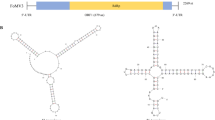Abstract
Fatsia japonica is an evergreen shrub native to Japan. For decades, virus-like ringspot symptoms have been observed on leaves of F. japonica in Japan; however, previous attempts to identify the causal agents have been unsuccessful. In this study, we detected an orthotospovirus-like sequence in symptomatic F. japonica plants using RNA sequencing analysis. The complete nucleotide sequences of the L, M, and S segments of the virus were determined using conventional sequencing strategies. The virus had a typical orthotospovirus genome structure, and the putative nucleocapsid protein showed the highest sequence identity to that of groundnut chlorotic fan-spot virus, with 83.7% identity at the amino acid level (which is below the 90% species demarcation cutoff for the genus Orthotospovirus). Although we could not confirm the pathogenicity of the virus in F. japonica due to difficulties associated with mechanical inoculation, its association with the observed symptoms was suggested by the fact that the virus was detected only in symptomatic leaf areas. Based on these results, we consider this virus, which we have named "Fatsia japonica ringspot-associated virus" (FjRSaV), to be the first representative of a new orthotospovirus species, for which we propose the binomial "Orthotospovirus fatsiae".


Similar content being viewed by others
Data availability
The complete genome sequence of FjRSaV-YA1 has been deposited in the DNA Data Bank of Japan under the accession numbers LC626335, LC626336, and LC626337 for the L, M, and S segment, respectively.
References
Abudurexiti A, Adkins S, Alioto D et al (2019) Taxonomy of the order Bunyavirales: update 2019. Arch Virol 164:1949–1965
Jones DR (2005) Plant viruses transmitted by thrips. Eur J Plant Pathol 113:119–157
German TL, Ullman DE, Moyer JW (1992) Tospoviruses: diagnosis, molecular biology, phylogeny, and vector relationships. Annu Rev Phytopathol 30:315–348
Oliver JE, Whitfield AE (2016) The genus Tospovirus: emerging bunyaviruses that threaten food security. Annu Rev Virol 3:101–124
Plyusnin A, Beaty BJ, Elliott RM, Goldbach R, Kormelink R, Lundkvist A, Schmaljohn CS, Tesh RB (2011) Family Bunyaviridae. In: King AMQ, Adams MJ, Carstens EB, Lefkowitz EJ (eds) Virus Taxonomy—Ninth Report of the International Committee on Taxonomy of Viruses. Elsevier/Academic Press, London, pp 725–741
Turina M, Kormelink R, Resende RO (2016) Resistance to tospoviruses in vegetable crops: epidemiological and molecular aspects. Annu Rev Phytopathol 54:347–371
Chiang TY, Chen SF, Kato H, Hwang CC, Moore SJ, Hsu TW, Hung KH (2014) Temperate origin and diversification via southward colonization in Fatsia (Araliaceae), an insular endemic genus of the West Pacific Rim. Tree Genet Genomes 10:1317–1330
Tsuchizaki T, Teranaka M, Yora K (1969) Virus diseases of garden trees. Plant Protection (in Japanese) 23:6–9
Okuyama S, Saka S (1978) Virus diseases of garden trees, 5: viruses on Camellia, Fatsia, and Aucuba. Proc Kanto-Tosan Plant Protect Soc (in Japanese) 25:83–84
Tokuda R, Nishikawa M, Hosoe N, Nijo T, Iwabuchi N, Yoshida T, Watanabe K, Maejima K, Yamaji Y, Namba S (2019) Complete genome sequence of a carrot torradovirus 1 isolate, obtained from Angelica keiskei in Japan. Microbiol Resour Announc 8:e00110-00119
Altschul SF, Gish W, Miller W, Myers EW, Lipman DJ (1990) Basic local alignment search tool. J Mol Biol 215:403–410
Chu FH, Chao CH, Peng YC, Lin SS, Chen CC, Yeh SD (2001) Serological and molecular characterization of Peanut chlorotic fan-spot virus, a new species of the genus Tospovirus. Phytopathology 91:856–863
Tsuda S, Natsuaki KT, Tomaru K (1991) Purification of tomato spotted wilt virus isolated from tobacco plants in Morioka, Japan. Jpn J Phytopathol 57:239–246
Amroun A, Priet S, de Lamballerie X, Quérat G (2017) Bunyaviridae RdRps: structure, motifs, and RNA synthesis machinery. Crit Rev Microbiol 43:753–778
Ferron F, Weber F, de la Torre JC, Reguera J (2017) Transcription and replication mechanisms of Bunyaviridae and Arenaviridae L proteins. Virus Res 234:118–134
Melcher U (2000) The “30K” superfamily of viral movement proteins. J Gen Virol 81:257–266
Silva MS, Martins CRF, Bezerra IC, Nagata T, De Ávila AC, Resende RO (2001) Sequence diversity of NSM movement protein of tospoviruses. Arch Virol 146:1267–1281
Meng J, Liu P, Zhu L, Zou C, Li J, Chen B (2015) Complete genome sequence of mulberry vein banding associated virus, a new tospovirus infecting mulberry. PLoS ONE 10:e0136196
Hassani-Mehraban A, Dullemans AM, Verhoeven JTJ, Roenhorst JW, Peters D, Van Der Vlugt RAA, Kormelink R (2019) Alstroemeria yellow spot virus (AYSV): a new orthotospovirus species within a growing Eurasian clade. Arch Virol 164:117–126
Muhire BM, Varsani A, Martin DP (2014) SDT: a virus classification tool based on pairwise sequence alignment and identity calculation. PLoS ONE 9:e108277
Kumar S, Stecher G, Tamura K (2016) MEGA7: molecular evolutionary genetics analysis version 7.0 for bigger datasets. Mol Biol Evol 33:1870–1874
OEPP, EPPO, (1999) EPPO data sheets on quarantine pests: tomato spotted wilt tospovirus. Bull OEPP/EPPO Bull 29:465–472
OEPP, EPPO, (1999) EPPO data sheets on quarantine pests: impatiens necrotic spot tospovirus. Bull OEPP/EPPO Bull 29:473–476
Author information
Authors and Affiliations
Corresponding author
Ethics declarations
Conflict of interest
The authors declare that they have no conflict of interest.
Ethical approval
This article does not contain any studies with human participants or animals performed by any of the authors.
Additional information
Handling Editor: Ralf Georg Dietzgen.
Publisher's Note
Springer Nature remains neutral with regard to jurisdictional claims in published maps and institutional affiliations.
Supplementary Information
Below is the link to the electronic supplementary material.
Rights and permissions
About this article
Cite this article
Kitazawa, Y., Nijo, T., Nishikawa, M. et al. Complete genome sequence of a new orthotospovirus associated with ringspot in Fatsia japonica. Arch Virol 167, 615–618 (2022). https://doi.org/10.1007/s00705-021-05300-x
Received:
Accepted:
Published:
Issue Date:
DOI: https://doi.org/10.1007/s00705-021-05300-x




